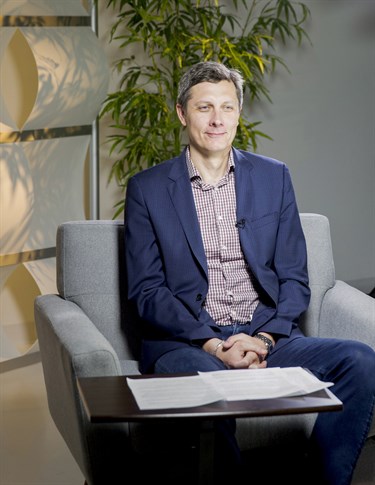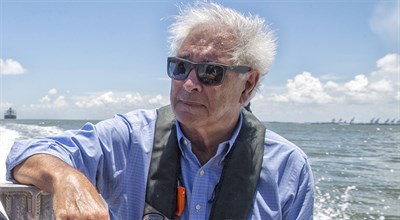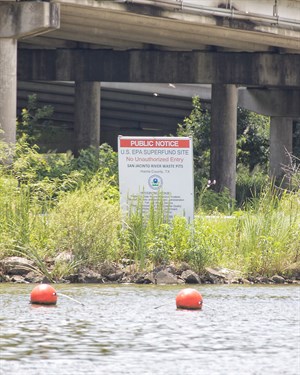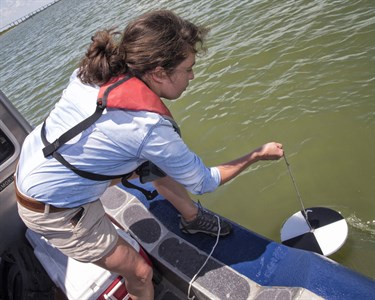Superfund Center Concentrates on Innovative Solutions
In September of 2008, when Hurricane Ike hit Galveston and Houston, waters as high as 15 to 20 feet flooded large areas and carried with it the sediment found in the Houston Ship Channel and Galveston Bay.

Was this sediment safe for the people being exposed to it? Was it toxic? Officials didn’t know.
Now, with the support of the National Institute of Environmental Health Sciences (NIEHS), a team of Texas A&M scientists is taking an innovative approach to offer solutions to these kinds of potentially disastrous natural and man-made emergency events before they happen.
The Texas A&M Superfund Research Center will develop a comprehensive set of tools that can be used by cities, counties, states, the federal government, and other entities to respond to disasters and mitigate the health and environmental consequences of exposure to hazardous mixtures during emergency-related contamination events.
Under the direction of Dr. Ivan Rusyn, professor in the Department of Veterinary Integrative Biosciences in the College of Veterinary Medicine & Biomedical Sciences (CVM), and Dr. Anthony Knap, professor of oceanography and director of the Geochemical and Environmental Research Group in the College of Geosciences, the center includes scientists from across the Texas A&M campus and partners from across the country coming together to conduct four environmental research projects funded by a five-year, $10-million grant.
The projects will include a study on the transportation and mobilization of complex environmental contaminants in sediments; the development of novel, low-cost, broad-acting sorption materials suitable for decreasing exposures to complex chemical mixtures; and the establishment of rapid laboratory tests that will help determine the types of human health and environmental hazards to which people may be exposed.
In addition, the center will tackle the challenges of understanding and measuring chemical exposures; create new approaches for analyzing “big data” from meteorology, analytical chemistry, toxicology, and geosciences; and help first responders and local, state, and federal government agencies make timely, science-based decisions.
Creating Solutions through Basic Research
All four projects will stem from a case study utilizing Galveston Bay and the Houston Ship Channel.
“There are a hundred years of chemicals in the sediment in the Galveston Bay due to the shallow depth and the proximity to a densely populated area. A hurricane or major storm will dislodge and mobilize many of the legacy chemicals in that sediment and eventually deposit it on land. That creates a completely new contamination scenario,” Knap said. “When that happened with Hurricane Ike almost 10 years ago, the local and state authorities had to act on general, standard procedures, not scientific evidence about this particular event.”

The problem was, not only did the regulatory agencies not know the types of chemicals or their toxicities, but they also didn’t know the concentrations of the chemicals in the sediment, nor the changes that occur when the layers of sediment mixed as the water levels rose with the flooding. They knew the sediment likely contained chemicals known to be hazardous because of the multiple industrial sources around the Houston Ship Channel, but they weren’t sure of the health and environmental impact.
“Of course, there is monitoring of the water and air quality, but they’re not worried about what’s actually in the sediment,” Rusyn said. “Surprisingly little is known about the fate and transport of chemicals in the sediment, especially in salt water as it is stirred up by a weather-related event.”
Texas A&M’s Superfund Research Center will investigate the many known and unknown factors of the sediments found in Galveston Bay; the research also will be readily translatable to other areas around the United States’ vast coastline.
“This project is going to make a lot of important discoveries, but most importantly, it is focused on providing solutions that are based on basic research,” Rusyn said. “Our goal is to measure as many factors as we can and then try to understand what else is in the exposure.”
“We’re also developing tools that can quickly determine the type of hazard and which concentrations could cause a problem,” Knap added. “This is where the ‘whole mixtures’ theme is important, because traditional decision-making is done one chemical at a time, but humans are exposed to mixtures of chemicals and, especially in these emergency situations, we don’t know the identities of the individual chemicals or their potential toxicities.”
This work also will be applicable to other emergency situations; as the ferocity and frequency of storms increase due to climate changes, coastal areas also will increasingly be at risk for weather-related disasters.
“It is well-known that subsidence and an increasing sea level are changing the vulnerability of coasts worldwide,” Knap said. “Adding a hurricane and toxic chemicals to this mix makes it essential to develop predictive models that can help provide information to responders.”
The new approaches and models being created also will be applicable to any type of emergency-response situation that may involve exposure to hazardous chemicals, according to Rusyn.
“This can be used for a chemical spill, for example, or an industrial area where an accident occurs; we may know what chemicals there are but we have no data on them. What do we do? How do we decide whether it’s safe or dangerous for people to be there?” Rusyn said. “If there is a problem right now, we cannot afford to just tell people to wait 50 years. It can’t be, ‘The scientists will figure it out;’ we need to make some immediate decisions: Do we move people out? Do we bring water in? Do we leave adults there but move pregnant women and children out? Those decisions need to be made quickly rather than within months or years.
“The potential is very high (for helping communities become more prepared),” he said.
Superfunding a ‘Legacy’

The Superfund program was established in 1980 by the federal government to fund cleanup sites contaminated with hazardous substances and pollutants. Through the program, the NIEHS provides funding to 18 universities across the country, most of them on the east and west coasts.
“The competition was strong; the applications were nearly a thousand pages long, and the NEIHS funded only nine or 10 proposals,” Rusyn said. “We’re a new program, so it’s a major accomplishment, and this university should be proud of having an outstanding team and unparalleled institutional support.”
The center also marks the return of a Superfund research “legacy” for Texas A&M, which had a long-lasting and highly successful Superfund project from 1989–2008.
“Our previous studies also focused on toxic chemical mixtures,” said Steve Safe, former Texas A&M Superfund director. “The newly funded project will provide novel and practical approaches for addressing critically important emergency exposures to toxic chemical mixtures.”
A majority of the existing NIEHS-funded Superfund programs focus on “legacy sites,” sites that are already polluted and have been studied for years or even decades. However, the Texas A&M center decided to do something different by focusing on preparedness for future disasters.
The center brings together researchers from the Colleges of Veterinary Medicine & Biomedical Sciences, Medicine, Geosciences, Engineering, and Science, as well as the School of Public Health and the Texas A&M Energy Institute. It also includes partnerships with North Carolina State University, the University of North Carolina-Chapel Hill, Baylor College of Medicine, and the Pacific Northwest National Laboratory, part of the Department of Energy.
“The reviewers said that our program was clearly one of those examples of when the entire program is greater than the sum of its parts,” Rusyn said. “They really were excited about how we presented ourselves as a team rather than a collection of individually excellent projects.
“Almost all of the activities will be here in College Station and in our partner sites, but we will work and collect samples with the coastal communities-anywhere from existing
research in the Houston Ship Channel by faculty from the School of Public Health to marine and coastal research carried out by colleagues in the College of Geosciences, as well as other studies in surrounding communities and underserved areas of Houston that flood all of the time,” Rusyn said. “All are in the area that will be used in our case study.”
Behind the Innovation
None of this would be possible without the support of Texas A&M and the Texas A&M Office of the Vice President for Research, which provided resources that enabled the center to coalesce around the central theme and will fund pilot projects, facilitate interactions within the center, support diversity, contribute additional trainee funding, and offer “boot camp” trainings to students, faculty, governments, and first responders.

“One of the reasons I came to Texas A&M was to develop and expand on new ideas; our program has been successful because there has been institutional support for creating and competing for marquee programs,” Rusyn said. “It’s something that is just unparalleled; in this current environment, many other universities are much less supportive. This university has been really spectacular in that regard.”
Many of the center’s lead investigators, including Rusyn and Knap, have been recruited to Texas A&M within the past five years, and the synergy between their scientific ideas has already led many to join research efforts that were funded by federal and state agencies, as well as by industry.
The prestige of the Superfund program grant and the new collaborations and grants that will arise also will give Texas A&M something in return.
“Having Superfund support is a major statement of a very serious commitment that this campus has made to environmental health,” Knap said. “Because this particular program has to combine biomedical and non-biomedical projects as a requirement, we really provide a unique opportunity for our trainees to cross train in environmental engineering, biomedical research, community engagement, and other areas.
“It’s a very broad, university-wide program and is meant to be a center of excellence, not just for itself but it also will bring additional research and additional funding because we are acting as a team.”
‘Communities’ Working Together
While the research is underway, the projects’ support, community engagement, and research translation cores will allow the teams to communicate their findings; offer the tools that were developed to assist first responders, impacted communities, and regulatory agencies involved in site management and cleanup; and address the health concerns of the populations that may be impacted by environmental emergency-related contamination events.
“Through our translation core, we will work to create packages that will serve as a how-to for affected areas, creating a process to empower both communities and governments with tools to actually make the right decision, because at present, a lot of decision are based not on information, but on emotion or other considerations,” Rusyn said. “We’re increasing resiliency of both the communities, but also governments in terms of understanding what to do when these events happen.”
To learn more about the Texas A&M Superfund, visit superfund.tamu.edu.


